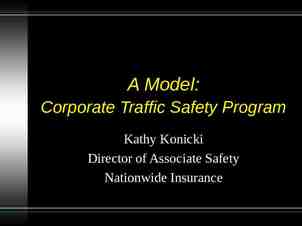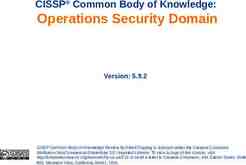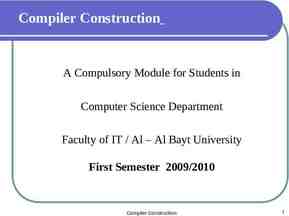Kentucky Lead Workgroup Recommendations KWWOA Annual
17 Slides3.43 MB

Kentucky Lead Workgroup Recommendations KWWOA Annual Conference Northern Kentucky Convention Center April 9, 2018 Greg Heitzman, P.E. BlueWater Kentucky 1

32 Recommendations of the Kentucky Lead Workgroup 18

State Level Recommendations (10) 1. Develop protocol, guidance and technical assistance for evaluation of treatment process changes using the US EPA’s Optimal Corrosion Control Treatment (OCCT) report published March 2016. A Corrosion Control Plan (CCP) should be developed when: a) b) c) d) a new water source is introduced (including interconnects with utilities); the water source is changed; the water treatment process is changed (including chemical additives); lead compliance sampling results are near or exceed the EPA Action Level (currently 15 ppb); e) an interim supply is needed (excludes emergency supply) A CCP is a complex analysis. To assure optimal water treatment quality is achieved and regulatory compliance is maintained, the CCP should be conducted by a qualified water quality professional. As recommended by EPA, the CCP should be developed in coordination with the Kentucky Division of Water. 19

State Level Recommendations (10) 2. Establish protocol and reporting requirements for utilities to use for the collection and reporting of special lead samples and when customers request water sample testing for lead. 3. Update the estimated number of lead service lines (public and private) in Kentucky and the associated replacement costs. 4. Revise prioritization criteria for state-wide water projects to include lead service line replacement. 5. Develop funding sources that utilities can use to finance lead service line replacement (public and private) and lead abatement projects. Funding sources may include: KIA, Rural Development, SRF funding, and state/local appropriations. 20 4

State Level Recommendations (10) 6. Develop a lead training curriculum in partnership with utilities, state and local health departments and water industry associations. The training should include corrosion control treatment methods, lead service line replacement and repair practices, flushing practices and customer communications. 7. Consider Kentucky state legislation for requiring blood lead level testing for all children at 12 and 24 months of age. 8. Update the Kentucky Division of Water’s website to serve as a resource for information on lead in drinking water, best practices, health impacts and regulatory requirements. 21

State Level Recommendations (10) 9. Promote the use of U.S. EPA’s 3T (Training, Testing and Telling) program for reducing lead in drinking water in schools and child care centers. The program includes: Training of school officials on the potential of lead in drinking water; Testing of drinking water in schools to identify potential problems and corrective actions (as needed); and Telling staff, parents, students and the local community about the testing results, potential risks and remedial actions taken by the school. 10.Monitor lead testing programs for schools and child care centers being used in other states and consider implementing in Kentucky following a review of benefits and costs. 22

Utility Recommendations (13) 1. Conduct a Corrosion Control Evaluation (CCE) and develop a Corrosion Control Plan (CCP) for water treatment and distribution operations following the guidance provided in US EPA’s Optimal Corrosion Control Treatment (OCCT) report published March 2016. A CCP should be developed when: a) b) c) d) a new water source is introduced (including interconnects with utilities); the water source is changed; the water treatment process is changed (including chemical additives); lead compliance sample results are near or exceed the EPA Action Level (currently 15 ppb); e) an interim supply is needed (excludes emergency supply). A CCP is a complex analysis. To assure optimal water treatment quality is achieved and regulatory compliance is maintained, the CCP should be conducted by a qualified water quality professional. As recommended by EPA, the CCP should be developed in coordination with the Kentucky Division of Water. 23

Utility Recommendations (13) 2. Adopt the EPA recommended guidelines for lead compliance sampling. 3. Prepare for a reduction in the EPA Lead Action Level from 15 parts per billion (ppb) to less than 10 ppb as part of a revised Lead and Cooper Rule (LCR). 4. Prepare for more frequent sampling cycles and more diverse sampling locations for LCR compliance. 5. Adopt a policy or practice to remove public lead service lines when exposed during excavation. Communicate the discovery of any private lead service lines to the homeowner/occupant. The communication message should define the homeowner’s responsibility for private plumbing, the benefits of flushing and the impacts of lead contained in plumbing fittings and fixtures. 24

Utility Recommendations (13) 6. Proactively investigate the location of public lead service lines using various methods (historical records, maps, construction plans, field surveys, home age, etc.). The service line information (public portion) should be added to the water distribution inventory, maps and records (include material type, age, condition, and other attributes where available). 7. Provide customers access to an on-line database of utilityconfirmed lead service line locations (public portion). 8. Adopt a long-term goal of replacing all lead service lines. The implementation practices and the time line associated with this goal will be based on local conditions and financial capability. 25

Utility Recommendations (13) 9. Develop consumer education materials on lead in drinking water in collaboration with industry associations, regulators and public health officials. The education materials should: include the health risks associated with lead; include guidance on common methods to reduce lead exposure; and identify the homeowner responsibility for private service lines and plumbing fixtures. The information should be provided to consumers and stakeholders through Consumer Confidence Reports, websites, social media, door hangers and other available communication methods. 10. Train field personnel to identify, locate, repair, and/or replace lead service lines and lead-containing fittings. 26

Utility Recommendations (13) 11. Monitor state and national best practices on managing lead in drinking water. Practical and feasible practices should be implemented where appropriate. 12. Review the ANSI/AWWA Standard C810-17 on Replacement and Flushing of Lead Service Lines (published November 1, 2017). The standard should be adopted where feasible and practical. 13. Develop a program to partner with the health department, public/private schools and childcare centers for testing, education and coordination of replacement of lead piping and plumbing fixtures within school and childcare facilities. The program should include a protocol for reporting results of lead testing to the utility, schools and child care centers, local health department and Kentucky Division of Water. 27

Industry Recommendations (4) 1. Develop a utility training curriculum on lead in drinking water, including: lead treatment (corrosion control); water sampling protocol; system assessment for lead; lead inventory; lead service line repair; lead service line replacement (public and private); the potential source of lead from homeowner plumbing fixtures; and communication materials for consumers. 2. Identify key stakeholders and develop lead communication tools, including web site links and templates, for utilities to use in communicating with customers. Utilize existing resources from national and local partners. The materials should include information on the homeowner responsibility for private lead service lines and plumbing fixtures that may be sources of lead. 28

Industry Recommendations (4) 3. Engage and educate key stakeholders on lead in drinking water. Key stakeholders include health departments, medical professionals, regulatory agencies, education officials, engineering professionals, building trades, homeowners and other organizations that are impacted by or establish policy or regulations regarding lead in drinking water. 4. Pursue financial assistance from local, state and federal agencies for public and private lead service line replacement, utilizing the State Revolving Loan Fund Program and other financial assistance programs for home lead abatement. 29

Research & Development Recommendations (5) 1. Develop technology to identify buried lead service lines (non-destructive). 2. Advance utility best practices for full (public and private) and partial (public portion only) replacement of lead service lines. 3. Conduct research on the impact of lead in drinking water on human health. This work will assist in identifying an appropriate action level for lead in drinking water. 30 14

R & D Recommendations (5) 4. Evaluate the cost effectiveness of point of use (POU) and point of entry (POE) treatment devices for lead removal as an alternative to treatment changes or lead service line replacement to achieve compliance with the Lead and Copper Rule lead action level (currently 15 ppb). 5. Conduct research to determine the best sampling methods to obtain a representative sample of lead in drinking water for purposes of Lead and Copper Rule compliance monitoring. 31

Approval Process and Next Steps The Kentucky Lead Workgroup met on February 21, 2018 and approved the final version on March 7, 2018 by email Recommendations were submitted to US EPA on March 8, 2018, as part of a Federal Consultation Process on the LCR (Peter Goodmann, KDOW) The Kentucky Drinking Water Council approved the recommendations on March 13, 2018 Final Report to be available in the summer 2018. 32

Greg C. Heitzman, PE Chair Kentucky Lead Workgroup 502-533-5073 [email protected] 33






